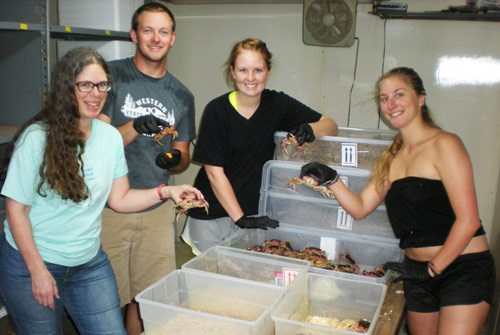Molting Gland Transcriptome Project

Current Project
CSU’s Crab Lab coordinates research that will create a catalogue, or transcriptome, of all the active genes in the molting gland of the land crab. A four-year, $982,000 grant from the National Science Foundation funds the project. Dr. Donald Mykles coordinates this research venture and forecasts, “I certainly expect we’ll be discovering things we had no idea even existed before.”
Molting Basics
The crab’s molting gland contains DNA, material that includes a specific set of genetic instructions that control when a gene turns on and begins to work. Not every gene is turned “on” all the time, but when it is, a gene controls certain aspects of a crab’s biology — like molting. RNA is a messenger molecule that delivers genetic instructions to parts of the cell that make proteins. Scientists measure levels of RNA to create a transcriptome. Since the levels adjust depending on which genes are active, transcriptomes like the one the CSU Crab Lab works on change based on a crab's body functions during different stages of molting. Many crustaceans, including land crabs, periodically shed their exoskeletons when they molt and then regrow their shells. Hormones within the animals coordinate the process in response to growth as an animal matures. “In order to survive, it must grow, and if it doesn’t, it dies,” Mykles explains. “It’s probably more critical for them than reproduction.”
Research Progress
CSU’s lab began the catalogue by collecting crab molting glands and sequencing the genes. They’re working to create a library of all the genes in the crabs’ molting glands, totaling from 40,000 to 50,000 sequences, and annotate the library with known functions of the genes. Once they have a basic catalogue, Mykles and the other scientists will determine which hormones are active during different stages of the molt cycle and how signalling in the molting process activates certain genes. They can measure different protein levels in each stage of molting and compare it to the catalogue in the non-molting, or intermolt, stage.
This major project requires scientists with different skill sets and different facilities. Dr. David Durica from the University of Oklahoma, Dr. Lars Tomanek from Cal Poly-San Luis Obispo and Dr. Ernie Chang from the Bodega Marine Lab all contribute to the project. Each lab as part of the partnership will help create the catalogue and design further experiments.
Laboratory Collaboration
Dr. David Durica is a geneticist and crustacean biologist from the University of Oklahoma who has experience with the high-throughput sequencing process necessary to compile the transcriptome. He previously worked to create a transcriptome for the RNA in the limb buds of crabs, which is why Mykles wanted him on the project. Durica also worked with the Oklahoma Medical Foundation to create a genome sequence, a catalogue of all the genes, of the crabs’ molting gland. The researchers compare the transcriptome (the product of gene expression) to the genome (the available genes) to determine which active genes control different aspects of molting. They identify key genes that activate during different molt stages.
The transcriptome will also be used as a reference to characterize proteins produced because of instructions from the genes. Mykles’ colleague Dr. Lars Tomanek specializes in studying protein, or proteomics. Tomanek works at Cal Poly - San Luis Obispo, and he’ll use the finished transcriptome as a reference to measure proteins produced throughout the molt cycle. With the transcriptome already prepared, Tomanek will translate the RNA message into specific proteins and then measure of each type.
The researchers meet periodically to discuss the progress of each piece of research and determine best practices and standard protocol for analyzing their findings. “The nature of the collaboration is really fun because not only are we sharing ideas, we’re sharing people,” Mykles explained. Many of Mykles students travel to Ernie Chang’s Bodega Marine Laboratory in California to work on projects and learn about collecting crab samples.
Research
- Background
- Molting Gland Transcriptome Project
- Molt-induced Muscle Atrophy
- Hormonal Control of Molting
